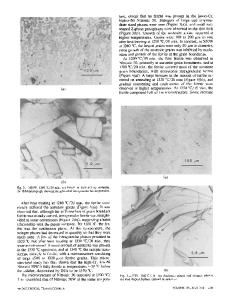Solidification and solidification cracking in nitrogen-strengthened austenitic stainless steels
- PDF / 3,743,005 Bytes
- 11 Pages / 594 x 774 pts Page_size
- 12 Downloads / 419 Views
I.
INTRODUCTION
N I T R O N I C 50 is a nitrogen-strengthened, austenitic stainless steel 1 with high strength and good corrosion resistance. The mechanical properties of this alloy, also known as 22-13-5 and XM-19, have been compiled by several authors 2"3'4 and the weldability has been assessed as very good. 5 A filler wire composition, NITRONIC 50W, has been developed for welding NITRONIC 50. Microstructural studies on NITRONIC 50 have been primarily on solid-state phase transformations which have been found to be complex. 6'7'8 Equilibrium austenite-ferrite phase distributions for one heat of NITRONIC 50 and one of NITRONIC 50W have been evaluated 8 and used to predict the solidification modes of these alloys. No extensive microstructural characterization of the weldments has been reported. A measure of the weldability of a stainless steel is its resistance to hot cracking, also known as solidification cracking. The tendency to hot crack has been related 9 to the amount of delta-ferrite retained in the weld at room temperature. A more important consideration is the solidification mode which the weld has undergone, with steels solidifying with ferrite as the leading phase more resistant to hot cracking than welds solidifying as primary austenite, ml'~2 Hot cracking in stainless steel welds is associated with the formation of low-melting constituents during the final stage of solidification. Therefore, solute elements which promote hot cracking are those which lower the effective solidus of the material, and the major elements linked with hot cracking are S and P. Concentrations of these ele*NITRONIC is a trademark of Armco Steel Corporation. ANN M. RITTER is Staff Metallurgist, General Electric Company Corporate Research and Development, P.O. Box 8, Schenectady, NY 12301. WARREN E SAVAGE is Professor Emeritus, Department of Materials Engineering, Rensselaer Polytechnic Institute, Troy, NY 12180. Manuscript submitted June 12, 1985.
METALLURGICALTRANSACTIONS A
ments in the final liquid regions are generally higher in the case of primary austenite solidification than for primary delta-ferrite solidification. This results from the higher solubility of S and P in ferrite than in austenite. Niobium is an element which has been observed ~5'16 to cause hot cracking by the formation of a Nb(C, N) eutectic. Since Nb is a ferrite-stabilizer, it partitions preferentially to the delta-ferrite ~3'14 so that primary delta-ferrite solidification should result in less partitioning of Nb to the final liquid, and therefore less hot cracking. The effect of Nb on hot cracking was studied using three heats. One of these heats was NITRONIC 50 which had a Cr,q/Ni~q ratio 5 low enough to result in primary austenite solidification by the austenitic-ferritic mode. 17 The other two heats were NITRONIC 50W, with Crcq/Nieq ratios high enough to result in primary delta-ferrite solidification by the ferriticaustenitic mode. 17One of these NITRONIC 50W heats contained 0.2 wt pct Nb, and all of the heats were of very low S and P levels to mi
Data Loading...











